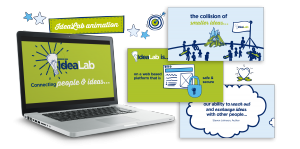Creating a culture of innovation and ideation is a top priority for so many organisations.
Many companies run employee ideas schemes and as a result, they’ve reduced costs, driven innovation, enhanced morale, increased customer satisfaction and improved processes.
But how do they do it? How come, more often than not, such schemes simply crash and burn? What’s the secret to success?
There are three crucial factors in managing a successful scheme – plan, listen and action.
Without a proper plan in place, you’ll be setting your scheme up for a fall by missing major steps and neglecting elements of the process. Creating a clear process and setting defined goals is crucial. And the absolute worst thing you can do is request ideas and then fail to listen when they come in. It’s vital to demonstrate the value you place in employee participation through the actions you take.
Where do you start?
Most idea programmes fail due to lack of planning and the wrong approach. So start with the right mindset.
Focus your campaign around a specific topic or opportunity for improvement. Seek early, impactful wins to create momentum. Start off on the right foot by speaking to managers, team leaders, innovation champions and supporters to obtain early buy-in and encourage promotion and support.
Your approach will need to be tailored to your organisation – factors such as size, structure and corporate culture can all make a difference. Arm yourself with the facts and adapt accordingly. Consider implementing these 10 steps for maximum impact and a super successful outcome:
- START SMALL. Start with a pilot scheme so you can test assumptions and identify innovation leaders. Link your pilot to a goal that you know the organisation is already working towards to capitalise on momentum and motivation. Limit the number of participants to begin with, only inviting a cross-section of employees to take part. Ensure you represent the different voices of your organisation but don’t feel compelled to turn it into a free-for-all. Remember to cast your net wide. Gather perspectives from diverse areas of the business, people with different expertise and experiences.
- POSE A DIRECT QUESTION ABOUT A SPECIFIC TOPIC. Set concentrated, targeted objectives and pick top of mind challenges that matter to the business. Build confidence and trust in the process by considering topics that link to specific benefits to your customers or employee job performance – safety, quality, productivity, etc. – things that will make employees’ jobs easier, safer or faster.
- AGREE A LIMITED TIME FRAME. Run the scheme for a set period, one month, for example. This will help to maintain momentum whilst keeping things manageable. Set different phases for the activity: ideation, refinement and voting for example.
- ADOPT A MARGINAL GAINS MINDSET. Take a ‘small steps’ approach rather than striving for huge leaps in innovation. Set realistic expectations and be open to suggestions that support incremental improvements. We love this example, when a chef at Pizza Express made a seemingly small-scale suggestion, the business was able to make a significant saving. Read about it here.
- USE IDEA MANAGEMENT SOFTWARE. Crowdsourcing based ideation platforms are simple to use and can be accessed by any device. They provide you with a way to track participation, collate, filter and evaluate submissions, identify trends and then score the winning ideas. Note – you may need to also offer a manual scheme alongside this for those without access.
- TIMING. Know what else is going on in the business. What busy periods should you avoid? What other campaigns could you end up competing with for attention? Use your knowledge and experience to launch the programme at the best possible time.
- INVOLVE AN EXECUTIVE SPONSOR. Demonstrate high-level buy in. They can rally the troops to get involved, help with securing budget and influence others when it comes to pushing chosen ideas through. Make sure they’re present throughout, not just at the start.
- PROMOTE INTERNALLY. Create excitement, enthusiasm and a sense of anticipation in advance. Give the scheme a memorable name. Develop a launch plan to create that initial buzz. Make the benefits clear –for individuals and the business. Consider the right channels to use – a short video or animation featuring your executive sponsor to share on the intranet, a series of emails to mark the countdown to launch, a feature in the employee magazine and creative use of the office environment. Find ways to maintain momentum and celebrate subsequent successes.
- INVITE ‘THE CROWD’ TO CO-JUDGE IDEAS. Public voting can play a powerful role in determining the success of your scheme. Demonstrate transparent, inclusive decision-making. When participants are involved from start to finish they will take ownership of the programme and be much more inclined to get involved in future schemes.
- PROVIDE RAPID FEEDBACK AND RECOGNITION. Be sure to publish next steps. Create a circle of continuous communication and feedback. Even if an idea is not approved, let people know why it’s not moving forward and encourage them to keep coming up with new ideas. Demonstrate how successful ideas have been implemented and publicly recognise star participants who’ve taken the time to get involved.
A winning example
 We worked with a client where innovation is a driving force, influencing every aspect of the business. They needed to spread the word about a new scheme. IdeaLab is a fresh online innovation space for employees to connect, share ideas and co-create solutions. We helped to create a feeling of excitement and anticipation in advance of the campaign. Then we drove engagement and involvement throughout the five week period. Engagement with IdeaLab went way beyond initial expectations. As a result, the campaign generated 199 ideas, 1200 idea views and over 18,000 votes leading to two winning ideas that directly addressed the initial challenges posed. You can see the full case study here.
We worked with a client where innovation is a driving force, influencing every aspect of the business. They needed to spread the word about a new scheme. IdeaLab is a fresh online innovation space for employees to connect, share ideas and co-create solutions. We helped to create a feeling of excitement and anticipation in advance of the campaign. Then we drove engagement and involvement throughout the five week period. Engagement with IdeaLab went way beyond initial expectations. As a result, the campaign generated 199 ideas, 1200 idea views and over 18,000 votes leading to two winning ideas that directly addressed the initial challenges posed. You can see the full case study here.
In summary
Of course, success will be determined by the goals you decide on and the expectations you set. So be sure to set out with realistic objectives and know how you will measure and evaluate. Note the successful elements of your campaign, the moments where things didn’t go quite to plan and the lessons you’ve learned. What were the biggest challenges you faced? What was it that got people racing to submit their ideas and vote on others? Did certain participants stand out from the crowd?
Crucially, close the loop. Follow the stories through and publish posts or videos about how ideas have been successfully implemented. Attribute successes to individual participants and demonstrate the value you hold in employees’ opinions. Think about developing a reward scheme to encourage further activity.
Ultimately, be clear about WHY you’re running the programme and what you need to achieve. By following the steps above, you should be able to create an ideas scheme that drives your people to take part and delivers real commercial results.
















